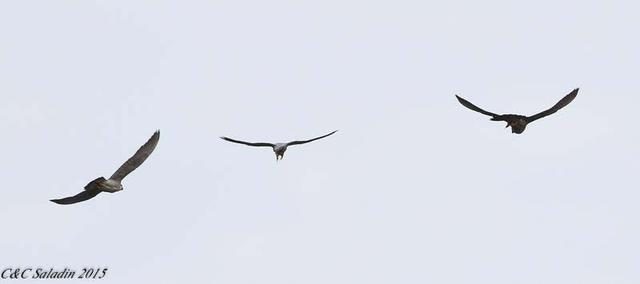FALCON FLASH
Dateline: Cleveland, Ohio
March 31, 2015
Click here to read what happened earlier
Here is a picture of Bolt, the male at a nearby nest, chasing off a one year old female who dared approach Bolt’s, and his mate Cuyahoga’s, nestsite. Can you tell which one is the male and which is the female?
Mr. Harvey Webster, Director of Wildlife Resources at the Cleveland Museum of Natural History, tells us, “The interval between egg-laying in Peregrine Falcons is usually 2 and a half days, that is, the time it takes the female to ovulate the yolk with ovum attached, allow for fertilization, attach all of the necessary components needed to assemble a Peregrine Falcon chick, create the chorio-allantoic membrane to surround it all and then create the eggshell. This is truly marvelous and complicated business!” Here is a picture of Mr. Webster out on the skyscraper’s ledge adjusting the FalconCam equipment.
Here’s an interesting falcon fact. Male peregrines are about one-third smaller than females and are called “tiercels”, which comes from an old French word meaning “one-third”. Female peregrines are fierce predators, and the larger females can be aggressive toward their mates. Some scientists believe the male approaches his mate cautiously and bows to her to as if to say “please don’t hurt me”, but since the male is a fierce predator also, he may be bowing to show his mate he is not a threat to her. In the following picture, Boomer bows to his previous mate.
In the following picture you can see a male making a scrape in the nestbox gravel.In the following picture, Bolt and his mate Cuyahoga, drive away the intruding female. Can you tell which ones are the two females and which one is the male?
Were you watching the FalconCam this morning? Here is Newton just before her first egg was laid:
Most peregrines have three or four eggs. Some young females may produce less and some females may have five or even seven eggs, but it seems to be difficult for most peregrine parents to keep up with feeding more than 4 hungry growing chicks. You can monitor the FalconCam archives over the next week to look for signs that more eggs are coming. Former volunteer nest monitor, Mr. Scott Wright, describes this stage as the "lethargic egg-laying phase where she will not stray very far form the nest. She will not fly much and in general, like any expectant female of any species, her activities will be naturally limited by the additional weight she is now carrying. Boomer is close by and has been feeding her, as the female will not hunt during this phase. The eggs (when they are laid) are laid every other day, four eggs will take 7 days to lay.” In the following picture you can see a female flying while carrying eggs. Since peregrines usually catch their prey (other birds) while flying you can see that she is weighted down and would not be able to fly or hunt normally.
From now on, Newton and Boomer will spend more time in the nestbox until the eggs hatch and their chicks are grown. You can count the frames in the FalconCam archive to see what fraction or percent of each hour is spent in the nestbox. It’s also a good idea to keep a falcon journal and record each day’s activities. Newton is an older female and last year she had only one chick. Will there be more eggs? Will the eggs hatch? Keep your eyes and browser set to: http://www.falconcam-cmnh.org/news.php
Don’t look down, Mr. Webster!
And here she is minutes later with her first egg. Congratulations, Newton and Boomer!
Our thanks to the Cleveland Museum of Natural History for sponsoring the FalconCams and for the stills. The photos of Mr. Webster and of Boomer bowing are courtesy of former volunteer peregrine nest monitor Scott Wright. All other photos are courtesy of volunteer peregrine nest monitors Mr. and Mrs. Saladin.
Click here to read what happened next








